Undertow (1949) / Outside the Wall (1950) / Hold Back Tomorrow (1955)
BLU-RAY STREET DATE: APRIL 4, 2023/KL STUDIO CLASSICS

Once again, KL Studio Classics brings forth a three-pack of rare, vintage films in its continuing series, “Film Noir: The Dark Side of Cinema”. By now, longtime collectors of Film Noir on physical media understand that the titles bundled in these collections aren’t always Film Noir. We’ve come to terms with that (even as this critic has opted to step away from writing up every new set in the series). This time, however, things are different. Volume XII, with its lack of big stars and satisfying style to compensate (for those who care about such things like stars), goes a solid three-for-three in the Noir department. The triptych of offerings spans from the end of the forties to the mid-fifties, with new 2K masters for each and new expert audio commentaries on two of them. (Unfortunately, the extremely unpackable Hold Back Tomorrow has no pertinent bonus features aside from its trailer. But it’s the only one that contains its own trailer). Only 1949’s Undertow, directed by future horror impresario William Castle and featuring a small pre-fame role for “Roc” Hudson, has any readily recognizable names. Yet, in true Noir fashion, The Dark Side of Cinema XII flips expectations on their heads, particularly the rule of diminishing returns…
Undertow
DIRECTED BY WILLIAM CASTLE/1949
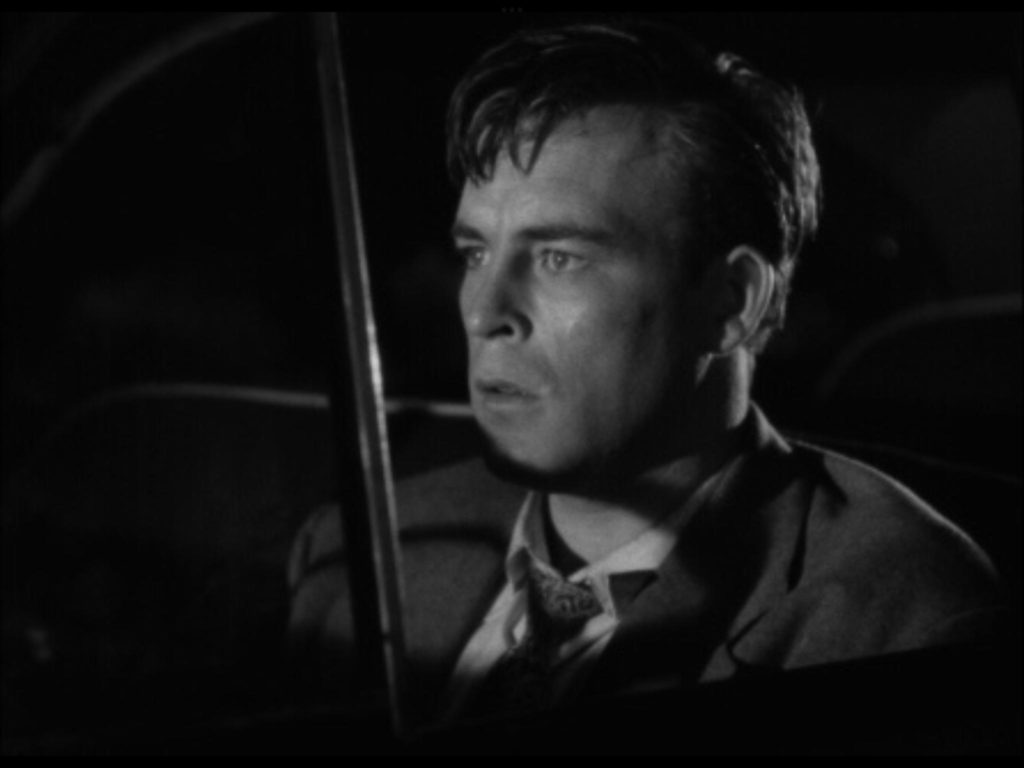
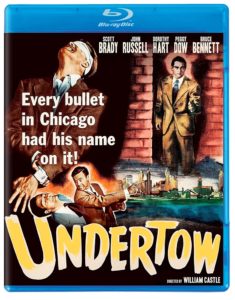
William Castle (Let’s Kill Uncle), best known for his hokey horror film exhibition gimmickry, helms Undertow, a taut little crime/Noir that chugs along accordingly. While the level of Hitchcockian prowess once again eludes Castle, he unquestionably demonstrates a directorial confidence and skill not reliant on the likes of seat buzzers or smell-o-vision or whatever else he’d later foist onto the moviegoing experience. Too bad he does not demonstrate such skill in the area of casting.
Was it Woody Allen who said that casting is 80% of a director’s job? Whatever the actual statistic and source, the point is that if you plug in the right actors, you, the filmmaker, are basically set. With Undertow, it’s the opposite. In a movie stocked with characters behaving like robot aliens, the lead, Scott Brady, goes all the more bug-eyed and spastic. Brady does that thing where every time he says something for emphasis, his face momentarily freezes on the final syllable. For him, this often results in a Simpsons-style overbite while the other person talks. Bleh.
Brady plays Tony, a former criminal who’s going legit. He’s even fixing to propose to his gal, Sally (Dorothy Hart). On his way back to Chicago he crosses paths with his old buddy Danny (John Russell), a Reno casino owner who’s also fixing to get hitched. The two guys sit and compare the shiny rings-in-waiting in their pockets. Before Tony hits the road, he advises a stranger, Ann (Peggy Dow), on the ins and outs of gambling with dice. Tony happens to meet up with Ann on the way home. Then, he’s violently framed for the murder of a mob boss. Every cop in the town is then looking for him. He can’t get to Sally, so Ann will have to do. Then the heat is really on…
Undertow makes good with some snappy banter and a hapless-everyman-in-over-his-head plot. For those watching with a checklist, it sports lots of classic tropes. In that same vain, it’s also worth noting that Undertow has more Black actors featured prominently than most other Hollywood movies of this era. These aren’t necessarily the most flattering roles, but at least one of them matters tremendously in the story. The film’s successful elements outweigh the not-great aspects, making Undertow a begrudging Noir thumbs-up.
In defense of Scott Brady, his son Tim Tierney is on the Blu-ray’s new audio commentary track, sharing all kinds of memories and insights about his dad. The recollections are great, and really make me wish I’d enjoyed Brady’s performance more. Checking Brady’s filmography, I’ve actually seen him in several other films where he apparently was just fine. Go figure. Professor and film scholar Jason A. Ney, however, does the real heavy lifting on this track, bringing in Tierney at opportune times (via seamless editing), and discussing other cast members in the meantime. Ney does a solid job of bringing things together, though oddly, he doesn’t have much to say about the legendary William Castle. One can only assume that’s because Castle’s been well covered numerous other places.
Outside the Wall
DIRECTED BY CRANE WILBUR/1950
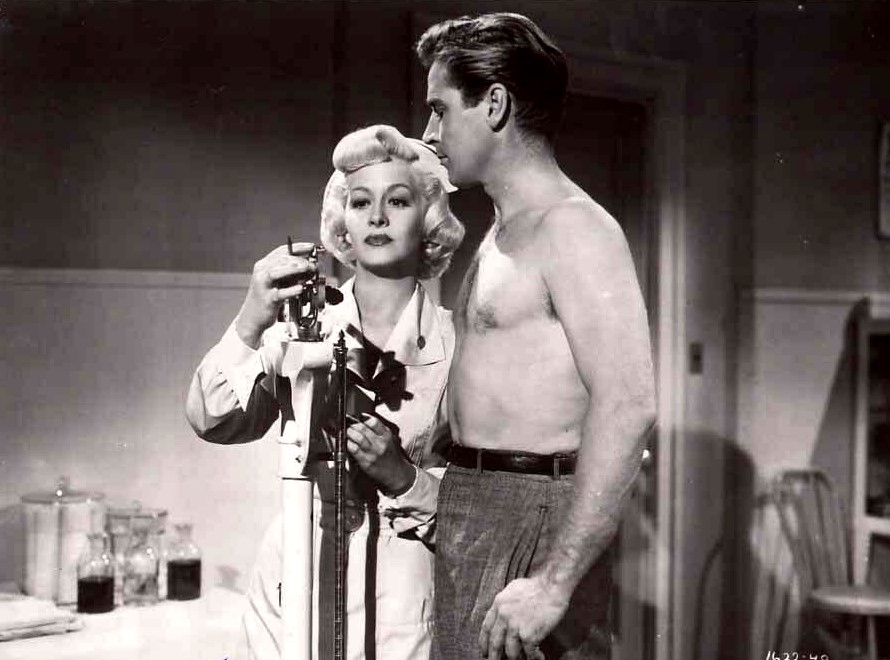
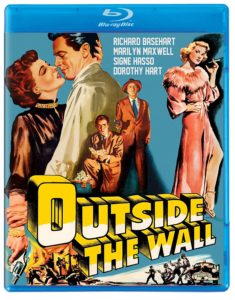
Silent film actor-turned-writer/director Crane Wilbur’s 1950 Film Noir Outside the Wall raises a big question. Namely, “Why did it take until volume XII of Kino’s “Dark Side of Cinema” series for this gem to be unearthed?? Not that it’s a horse race, but Wilbur’s precise and volatile Outside the Wall is a far more effective Noir entry than so much of what populates the earlier sets.
Richard Basehart (Fixed Bayonets!) is at his most alternately hardened and vulnerable in the lead role of newly freed ex-con Larry Nelson. Having been in the big house since he was convicted for (accidental) murder at age fifteen, Larry’s literally spent half his life in prison. When he’s finally released, he has no intention of ever going back. But the world of 1950 is a lot different than the world of 1935. Wilbur plays up Nelson’s fish-out-of-water aspects to the extreme, going so far as to depict him wandering into speeding traffic just the get across the street. If this guy has no knowledge of traffic signals, how the heck is he gonna be with women?? (Answer: painfully naïve).
In his quest to stay on the straight and narrow in this loud and different world, Nelson takes a low-paying dead-end job as an orderly in a sanatorium. At least things are quite there. He even catches the eyes of a couple of young nurses, the vampy gold-digger Charlotte (Marilyn Maxwell) and the nice girl, Ann (Dorothy Hart). But when armored car thief ringleader Jack Bernard (John Hoyt) is admitted under a false name (and a bursting bag of stolen cash, shhhh…), it seems that trouble has once again found Larry. Will he allow his blind desire to please Charlotte take him into Bernard’s world in exchange for a few lousy bucks?
Author/film historian Alan K. Rode provides an new audio commentary for Outside the Wall. Rode plays it very straight for the most part, taking us on a lot of little deep dives and side routes, but never veering far the film itself. It’s a dense but satisfying track that goes down better in increments. Outside the Wall itself, on the other hand, is an absolute winner that you won’t want to walk away from.
Hold Back Tomorrow
DIRECTED BY HUGO HAAS/1955
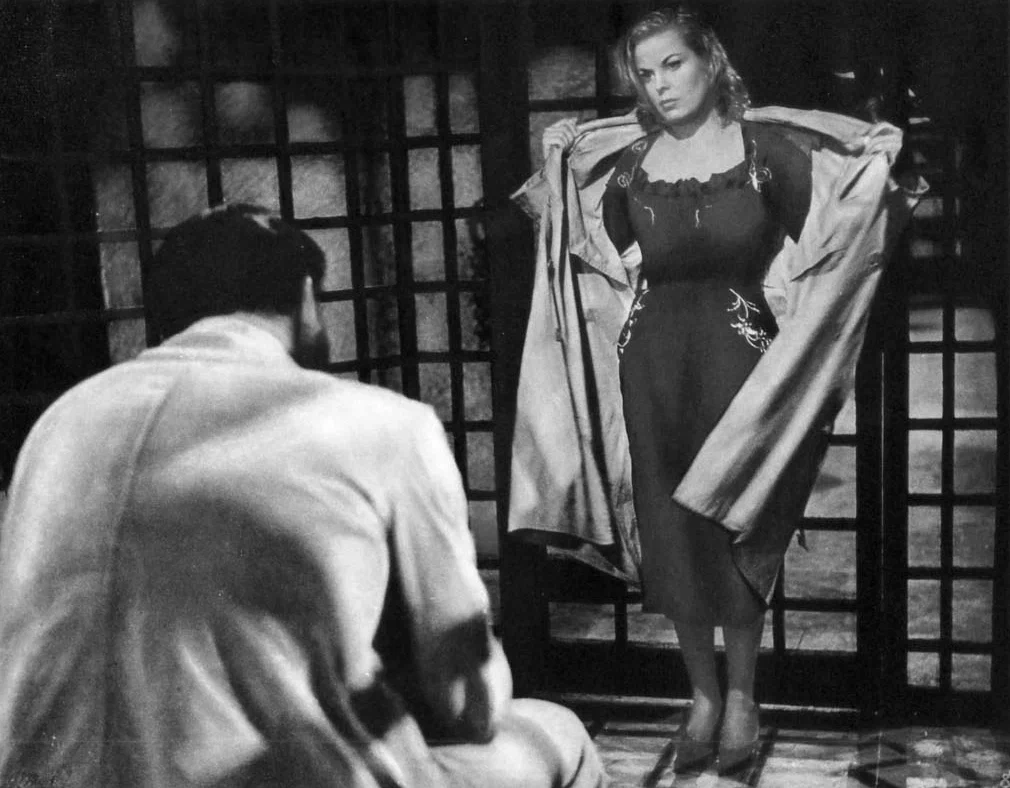
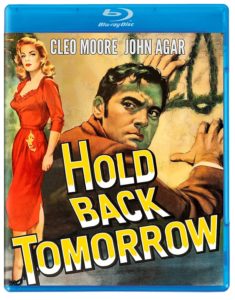
She can’t smile. He can’t cry. So goes the character breakdown in the trailer for 1955’s ultra-contained Film Noir, Hold Back Tomorrow. A sharply acted and sparsely directed two-hander, it would be a conservative estimate to say that eighty percent of the seventy-five-minute film takes place in a single prison cell.
Its is a death row prison cell on convicted strangler Joe Cardos’ final night. Joe (John Agar) is in a rage as he decides to push the limits of a law that grants an inmate any wish in their last twenty-four hours. He demands “a party”… Hays code-era parlance for a sexually willing female. Hold Back Tomorrow pushes the mid-century envelope in that the prison officials then have a scene in a brothel where they explain the situation to the Madame. She tells them that girls are all too scared to take the gig, so they’ll have to look elsewhere. The capper is the Madame’s quip, “I’d go if I were younger. I’d love to be strangled by a professional!”
They end up recruiting Dora (Cleo Moore), a twenty-five-year-old self-ascribed hopeless case who opens the film by stepping off a pier to die. To her dismay, she’s rescued and ends up at home. Then, before she can even dry off, those desperate officials show up, and make her an offer. She says yes, though not for the money. It’s the high probability of being murdered that appeals to her. (Now this is Noir!)
Written and directed by Czech actor/filmmaker Hugo Haas, the starkly monochromatic Hold Back Tomorrow cultivates and maintains a taut, stripped down, and thoroughly mature tone. Once Dora gets to Joe’s cell, the film primarily stays there, only cutting away briefly for his sister to lament his hardened, doomed heart. Agar and Moore, together again after 1954’s Bait, exude a refreshingly natural chemistry. Though Hold Back Tomorrow is regarded as a B-picture at best, it hits on all cylinders as a top-of-the-line dramatic effort- resonant, complex, sexy, and melancholy- all with a clock ticking down to Joe’s inevitable hanging.
The film’s immediate underlying drama expertly tips into melodrama with barely ever leaving the cell. The screenplay could quite easily translate to a stage play. The leads have effortless and potent chemistry, elevated by their completely naturalistic acting. As far as wide-open-to-interpretation endings go, Hold Back Tomorrow is one of the prime examples, likely dark to a knife-twisting degree, but also tossing out a hope for viewers who insist on such a lifeline. It is the opinion of this reviewer, however, that Haas understood the Noir form to the expert degree that he built up to what might be the ultimate subversive film conclusion of the Eisenhower era. We should not hold back our feelings, but nothing can hold back tomorrow.
*****
Huh! Maybe I’ll start back up with these KL Film Noir sets. They do have a way of pulling me back in…

